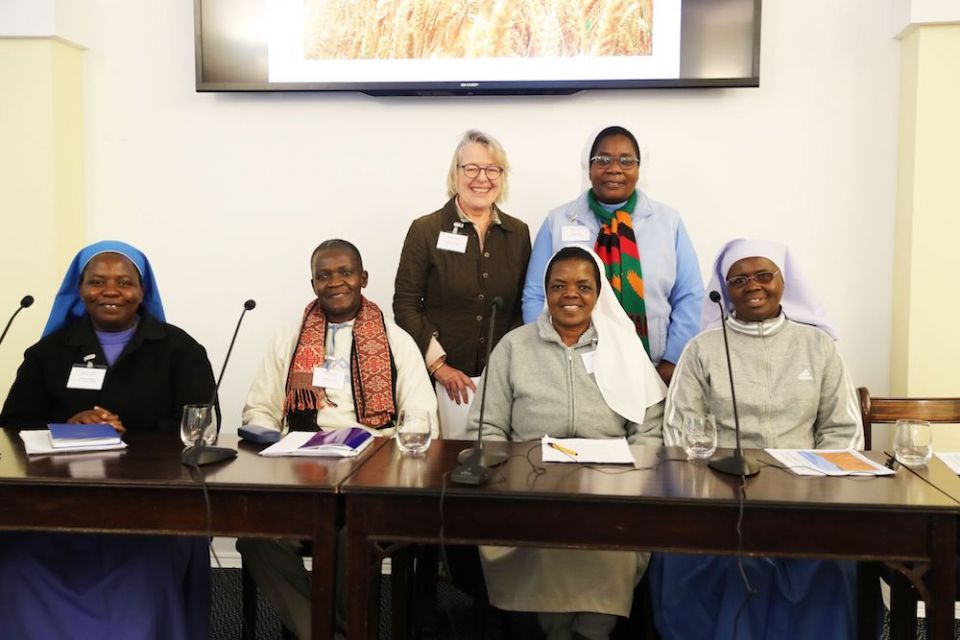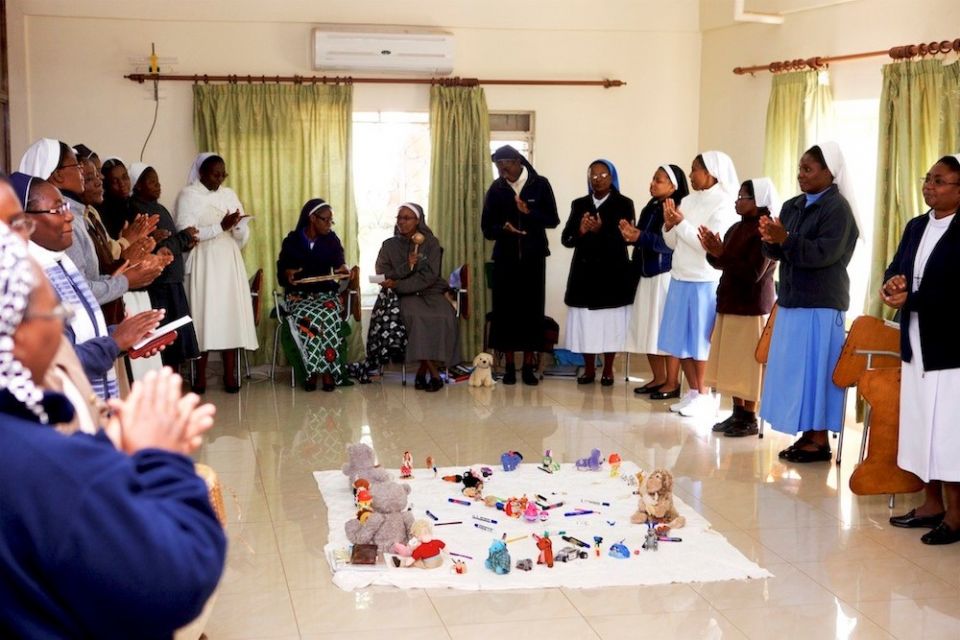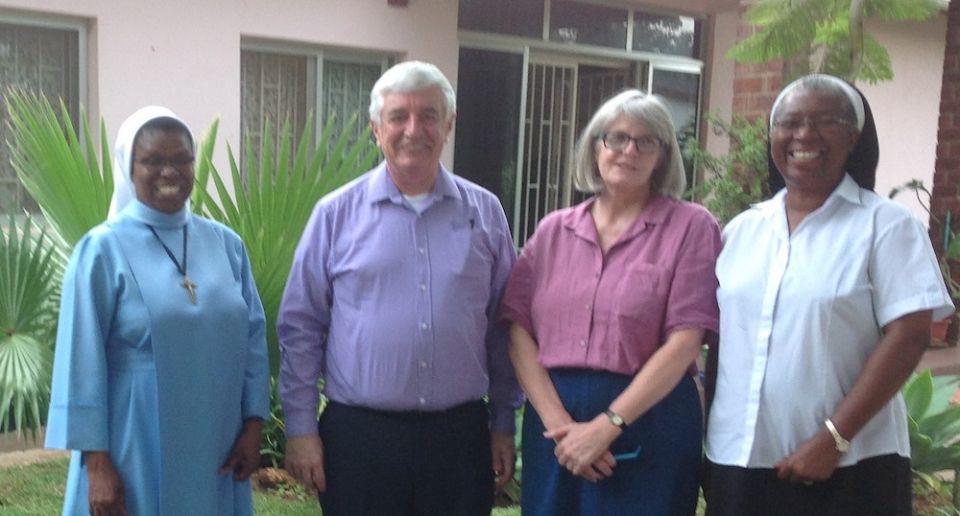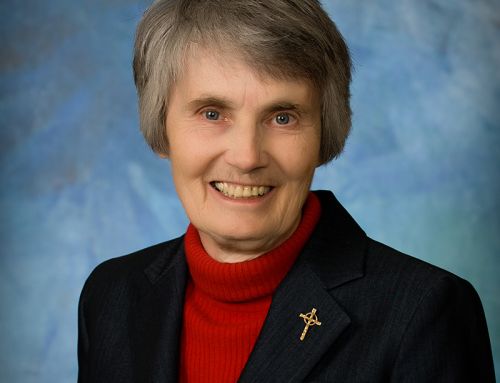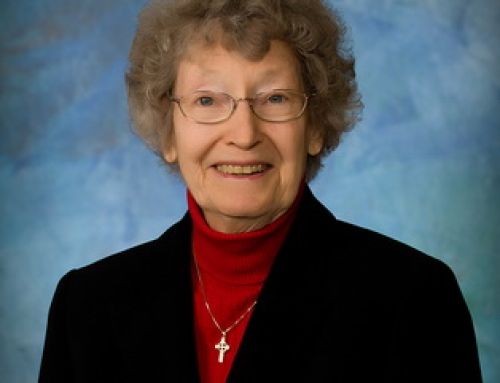Study of East African congregations finds gaps that challenge religious life
Many of the issues stem from economics
Research focused on religious life in five countries of East and Central Africa: Kenya, Zambia, Uganda, Tanzania and Malawi. Congregations of Catholic sisters from these countries were invited to participate and to attend the symposiums where the research was presented. At the symposium in London are, standing from left: Prof. Janet Soskice, who conducted the group interview with the sisters at the symposium, and project support assistant, Sr. Helen Kasaka, Little Servants of Mary Immaculate, Zambia). Other project support assistants, seated from left: Sr. Christine Kaneema, Daughter of Mary, Uganda; Sr. Margaret Sewe, Institute of the Blessed Virgin Mary, Kenya; Sr. Scholastica Mwale, Sister of Charity of Ottawa, Malawi); Sr. Deusdita Lutego, Congregation of Saint Theresa of the Child Jesus, Tanzania. (Anthony Kelly)
When I went to Zambia as a missionary in 1981, religious life looked very different than it does today. Most women religious were missionaries, diocesan congregations were very few, with some just starting. Now, those new groups are thriving, evidence of the Spirit and the women’s strong sense of call.
Most of these new congregations, as in other African countries, were mentored by missionaries until they reached a stage where they took on the responsibility for the congregation themselves. In meeting many of these diocesan congregations, I am inspired by their resilience and perseverance in undergoing many challenges in their beginnings. Now, after having established themselves as institutions, they are reviewing this evolution and finding some gaps that are inviting change.
In the past four or five years, looking to the future, many of the East African women religious, locally founded groups and provinces of international congregations whose membership is primarily African have been reflecting on the sustainability of their unique congregational charisms and spiritualities.
Recent studies have sought to uncover current understandings of how sisters integrate their specific charisms and spiritualities into daily life and transmit them in current initial and ongoing formation programs. The studies were also designed to reveal strengths and gaps in how sisters understand the primary elements of apostolic religious life: vows, prayer, community life and ministry and the impact of African cultural values and current local and global influences. The ultimate goal of the studies was to identify and strengthen the positive findings and address any important issues that surfaced.
In Zambia, the study “Sowing Bountifully,” is the result of a collaboration of the International Union of Superiors General (UISG), Zambia Association of Sisterhoods and GHR Foundation. It began in 2015 and was completed in 2016. Uganda Association of Religious is currently undergoing a study of religious life in their country, also funded by GHR Foundation.
The Religious Life Vitality Study in the U.K. began in 2016 and was completed in 2019. A separate study focused on religious life in five countries of East and Central Africa: Kenya, Zambia, Uganda, Tanzania, Malawi; and congregations of Catholic sisters from these countries were invited to participate. The research was funded by the Conrad N. Hilton Foundation’ Catholic Sisters Initiative. (The Hilton Foundation is also a funder of Global Sisters Report.)
Results and analysis were shared in two symposia held in October 2019, the first at the UISG Center in Rome and the second at the University of Notre Dame international center in London. The final reports will be made available this year. The research was carried out by a cross-institutional team based at the Centre for Catholic Studies, (CCS) Durham University and the Margaret Beaufort Institute of Theology (MBIT), Cambridge, United Kingdom.
The specific goals of the studies differed but common themes surfaced. The goal of the CCS/MBIT research was to uncover how the sisters interpreted and lived their charisms and missions in daily life and ministry in the church, along with perceptions about formation and recruitment for the future.
The CCS/MBIT study uniquely included reflections by the sisters on how they experience themselves, and how they believe others see them, as part of the church structures. I found this discussion interesting as sisters described unsatisfactory/conflicted relationships with bishops, clergy and lay people. Some do not feel clear about their role in the church, experiencing expectations of priests and bishops that their only role is to do the bidding of the clerics, and expectations of lay parishioners that their only role is to pray and not to be engaged in social or pastoral work.
These perceptions exclude how the sisters would like to function according to their special congregational mission and charism. Although contracts outlining expectations are more common between sisters’ congregations and bishops or priests regarding the ministries of the sisters, the day-to-day expectations can be different. It seemed clear how little bishops, clergy and laity understand apostolic religious life and its role in the Catholic Church. This lack of understanding can make it appear that religious congregations and their apostolates are somehow not part of the church’s mission.
The Zambia study goal was “to help congregations reflect on the changing local and global contexts of mission and the implications for formation, choice of ministries and education and training of sisters.”
An overarching theme that emerged through the studies was the sisters’ strong love for religious life, their congregational charisms and missions. The sisters clearly understood the need for strong spirituality development, both personal and communal as the basis for community living and ministry commitments and thus sustainability of their groups. Common and individual prayer, community life and understanding and interiorizing the charisms were elements identified as essential for sustainability of congregations into the future.
Many issues surfaced in the studies, but I am choosing only a few to focus on. Before identifying these, an issue I have often heard articulated among local African congregations, and implied but not specifically noted in these two study reports, is the uncertainty for some congregations about their foundational charism and spiritual heritage and how to uncover/recover it. The reason for uncertainty is that bishops sometimes founded a congregation primarily as a work force, without much understanding of the spiritual and Gospel mission dimensions of consecrated life.
Common issues included the need for better understanding of human development and the need for individual mentoring in personal and spiritual growth needs. The impact of technology, particularly phones, emerged as an issue. Each study noted that addiction to or over-use of phones and access to the internet can have grave negative impact on personal commitment to religious life, community living and ministry through distraction and poor use of time.
Globalization was also mentioned, whereby sisters are impacted by international fashion, music and attitudes and behaviors that can undermine religious life, values and decorum. Globalization has also encouraged individualism and careerism that has led to competitiveness and a weakening of common life.
Competitiveness can arise when access to professional education and training is limited by expense, so that only a few are given opportunity. Congregations may also hesitate to send sisters for education fearing loss of temporary or even final professed sisters who leave the congregation once they have obtained degrees. When this happens, the entire congregation suffers, as capacity of the entire group is slowed by loss of talent.
Studies also revealed that inadequate funding is a major inhibitor for implementing both initial and ongoing formation programs. There is an apparent general shortage of well-trained formation personnel, and a lack of available well-educated lecturers for theology, spirituality and human development courses.
Limited access to reading materials was also noted. Few congregations have updated libraries. I have visited houses of formation that have two or three shelves of books and most are from the 1970s, probably given to the sisters by departing missionaries. Books usually need to be imported and are expensive. Although there are online opportunities for materials, limitations of internet access and electricity make it nearly impossible to access them. Nor do all sisters have required technology skills for such programs.
Collaboration among congregations at the national conference level in providing programs for sisters in initial and ongoing formation has become common. However, there are still obstacles that make it difficult for sisters to attend, usually related to cost of travel, lodging and loss of income when sisters are absent from ministry assignments.
Another issue noted in the studies is the stress of balancing religious life responsibilities of prayer, community life and ministry. Communal prayer can begin as early as 5 or 6 a.m. followed by long hours at ministry, and later, by work in the community gardens to help produce food or carry out other household responsibilities. Superiors noted burn-out among their members, and sisters themselves described exhaustion that made it nearly impossible to engage in community life and prayer. Some also mentioned how exhaustion can lead to addiction to television or even alcohol when used for relaxation.
The studies noted the need for ongoing formation programs to keep individual commitment and the vitality of the congregations strong. Even though superiors note the prevalence of burn-out, the challenge is again economic. Allowing sisters to have a break from ministry to avoid burn-out usually means loss of income for the congregation and sometimes loss of placements in hard-to-get government-paid posts.
Underlying most of the “gap” issues of the studies was economics. Many congregations do not have established economic policies that could help guide sisters in use of congregational funds and resources. Such a situation sometimes leads to individual hoarding of salaries or finding alternative ways of procuring funds for private use or providing for their families. It was noted in the studies that few sisters are trained in finances and economics or budgeting and accountability. These skills and policies would help foster collective responsibility for the common good that lies at the heart of religious community life.
As I reflected on these studies, I was struck by how financial insecurity might impact the future sustainability of the congregations, even spiritually. Generally, the sisters do not have adequate capital for education, training, renewal or even health care. There is ongoing struggle to generate funds to cover these costs because payment from diocesan or parish ministries, in which a majority of sisters are engaged, is extremely minimal. Sisters seek secular work because it pays better, but this is a loss of talent for church ministries. It seems there is great need for the congregations to find ways to collaborate with each other to meet these common economic needs, and particularly to break away from dependence on resources from overseas donors, another issue noted in the research.
The purpose of the studies was to identify and articulate issues that are important to consider for sustainability of apostolic religious life in East African congregations and together as congregations and national conferences of women religious to work together to find solutions. There is a lot of talent in the sisters, so they will no doubt meet these challenges as they have met others in the past.
To learn more about the Global Sisters Report or to read other articles, please click HERE
[Joyce Meyer is a member of the Sisters of the Presentation of the Blessed Virgin Mary and is GSR’s liaison to women religious outside of the United States.]
